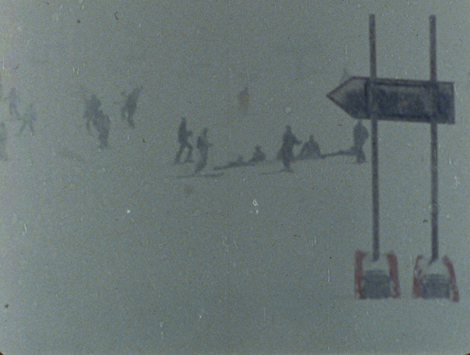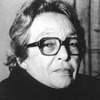Magic
Mountains
Could it
be by chance? Two of the richest and most accomplished works we have seen
in the festival are set in the mountains, and even more coincidently in the
Alps, somewhere above the city of Grenoble. In Didam and Tahousse, two films
that can be seen as a diptych, Mahine Rouhi and Olivier Fouchard set their
cameras in grandiose virgin landscapes and edit their film to the rolling
of thunder or the shadow of a cloud passing. The intense work on the film
medium (colors, contrasts, negatives) reinstates nature as piercingly primeval,
the origin of the world so distressing for mankind (who appears from time
to time as a fragile silhouette wandering in the open space), reminding us
of Carl Brown’s films, in which the photochemical work brings us back
to a world of initial sensations, and of Jose Val Del Omar’s cosmogonic
cinema to which one could reasonably doubt there was such a beautiful lineage.
Although it is probably more of an accident, the similarities are striking:
the atmospheric fast-motion, the mysterious ode to elementary forces that
the images convey, the tinting that, far from “colorizing” nature,
brings out the hidden and the timeless in it.
Nicolas
Rey’s film Schuss! could seem to have an opposite goal, since the mountains
he films have been harnessed and made profitable for ski resorts and the hydroelectricity-reliant
aluminum industry. The film is organized in chapters repeating the same structure
made from heterogeneous elements (portraits of skiers filmed with an old color
system rebuilt by the filmmaker and giving the shots a ghostly aura; rolling
facsimiles of reports of the board of directors of an electrometallurgy company;
comments by the filmmaker about the links between industry and war; old amateur
films on 9.5mm showing in particular skiing in an early resort, etc.) forming
a work of historical research whose materialist principle — to produce
a meaningful constellation through editing — recalls Walter Benjamin’s
work on 19th century Paris. Starting from a comparative postulate (cinema,
aluminum and ski industries were born around the same time and have witnessed
parallel growth to the rhythm of war efforts in the first half of the past
century), the filmmaker undertakes an archeology of the historical strata
of that “mountain” seen as a symptom of the century, confronting
the telltale signs of its industrial past with its timeless present of silhouettes
sliding down the white hills, almost disappearing into the film material.
And maybe the most striking image is a shot of skiers appearing out of the
grainy, timeless mist of what is probably the arrival of a cable car, surprisingly
resembling a milestone in the history of cinema: workers leaving a factory.
Suddenly, their apparently innocent activity represents catastrophe: man harnessing
nature through his industry, only to accelerate his own end, forever going
schuss!
From the
virgin mountains to overexploited mountains, the same tragic morality pertains
(a fact that could make these films close to some of Straub’s, albeit
their formal choices): mountains stand alone, as do men, and their solitudes
seem forever non-reconciled.
Emeric de
Lastens
Festival des cinémas différents de Paris, december 2005.

